
Windsor is a city in southwestern Ontario, Canada, on the south bank of the Detroit River directly across from Detroit, Michigan, United States. Geographically located within but administratively independent of Essex County, it is the southernmost city in Canada and marks the southwestern end of the Quebec City–Windsor Corridor. The city's population was 229,660 at the 2021 census, making it the third-most populated city in Southwestern Ontario, after London and Kitchener. The Detroit–Windsor urban area is North America's most populous trans-border conurbation, and the Ambassador Bridge border crossing is the busiest commercial crossing on the Canada–United States border.

Amherstburg is a town near the mouth of the Detroit River in Essex County, Ontario, Canada. In 1796, Fort Malden was established here, stimulating growth in the settlement. The fort has been designated as a National Historic Site.
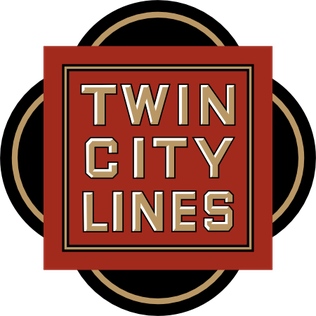
The Twin City Rapid Transit Company (TCRT), also known as Twin City Lines (TCL), was a transportation company that operated streetcars and buses in the Minneapolis-St. Paul metropolitan area in the U.S. state of Minnesota. Other types of transportation were tested including taxicabs and steamboats, along with the operation of some destination sites such as amusement parks. It existed under the TCRT name from a merger in the 1890s until it was purchased in 1962. At its height in the early 20th century, the company operated an intercity streetcar system that was believed to be one of the best in the United States. It is a predecessor of the current Metro Transit bus and light rail system that operates in the metro area.
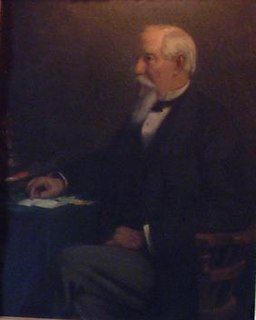
Hiram Walker was an American entrepreneur and founder of the Hiram Walker and Sons Ltd. distillery in Windsor, Ontario, Canada. Walker was born in East Douglas, Massachusetts, and moved to Detroit in 1838. He purchased land across the Detroit River, just east of what is Windsor, Ontario, and established a distillery in 1858 in what would become Walkerville, Ontario. Walker began selling his whisky as Hiram Walker's Club Whisky, in containers that were "clearly marked" and he used a process to make his whisky that was vastly different from all other distillers.
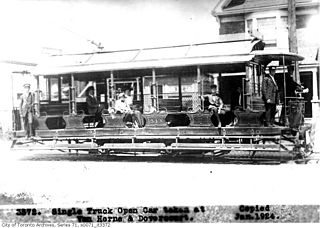
The Toronto Railway Company (TRC) was the operator of the streetcar system in Toronto between 1891 and 1921. It electrified the horsecar system it inherited from the Toronto Street Railway, the previous operator of streetcar service in Toronto. The TRC was also a manufacturer of streetcars and rail work vehicles, a few of which were built for other streetcar and radial operators.

The North Yonge Railways was a radial railway line operated by the Toronto Transportation Commission from 1930 to 1948 between Glen Echo (Toronto) and Richmond Hill. The line was created by reopening the southern portion of the TTC's Lake Simcoe radial line that had closed in 1930.

The San Diego Electric Railway (SDERy) was a mass transit system in Southern California, United States, using 600 volt DC streetcars and buses.
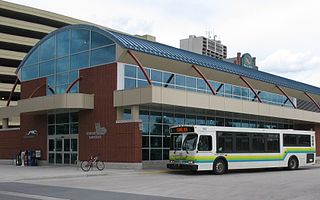
Transit Windsor provides public transportation in the city of Windsor, Ontario, Canada as well as LaSalle, Essex, Kingsville, and Leamington and serves more than 6 million passengers each year, covering an area of 310 km2 (120 sq mi) and a population of 218,000. They operate a cross border service between the downtown areas of Windsor and Detroit, Michigan via the Tunnel Bus, and service to events at Detroit's Comerica Park, Little Caesars Arena, TCF Center, and Ford Field. The Windsor International Transit Terminal neighbours with the Windsor International Aquatic and Training Centre.
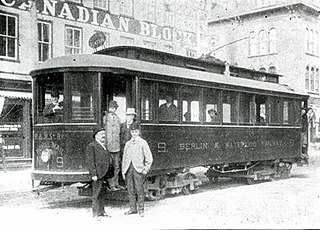
The Kitchener and Waterloo Street Railway was a street railway in Berlin and Waterloo in Waterloo County, Ontario, Canada. Horsecar service began in 1888 under the original Berlin and Waterloo Street Railway name and continued until the system was electrified in 1895, when the existing horsecars were converted for electric service. This proved ineffective, and the company suffered from under-investment. In 1896, a local consortium bought out the company and purchased a new fleet of purpose-built electric trams. The system was municipalized in 1907 and was run by the Town of Berlin/Kitchener until the end of service. The railway was renamed in 1919 to reflect the name change of the City of Kitchener, which had occurred in 1916. In 1927, it was reorganized under the Kitchener Public Utilities Commission, which continued operations until 1946, when streetcar service was discontinued and replaced with trolleybus service.

Essex Terminal Railway is a Canadian shortline terminal railroad, running from the City of Windsor, Ontario through LaSalle, to Amherstburg, Ontario, for a distance of approximately 21 miles (34 km). ETR has direct connections to Canadian Pacific Railway, Canadian National Railway and CSX. ETR is owned by Morterm Holdings. Founded in 1902, it is one of the oldest existing railways in Canada.
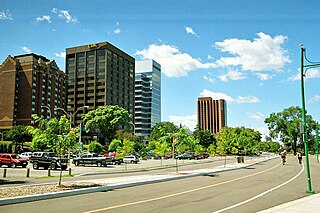
The Roy A. Battagello River Walk Bike Trail is the current backbone of the "Windsor Loop" bike trail network in Windsor, Ontario. The bike trail travels from the foot of the Ambassador Bridge, to traffic lights at Riverside Drive and Lincoln Avenue. This makes the trail the second-longest trail in the City of Windsor, at 8.0 km.
Windsor, Ontario has a very diverse population, and this diversity is shown in its many neighbourhoods. Windsor has twenty in all, ranging from rural farmland to densely built-up areas.

Streetcars or trolley(car)s were once the chief mode of public transit in hundreds of North American cities and towns. Most of the original urban streetcar systems were either dismantled in the mid-20th century or converted to other modes of operation, such as light rail. Today, only Toronto still operates a streetcar network essentially unchanged in layout and mode of operation.

Leamington Transit is the current mode of public transportation in Leamington, Ontario Canada. It consists of a micro coach that services the town of Leamington making regular routes Monday to Saturday, 7:00 am – 7:00 pm.

The Detroit United Railway was a transport company which operated numerous streetcar and interurban lines in southeast Michigan. Although many of the lines were originally built by different companies, they were consolidated under the control of the Everett-Moore syndicate, a Cleveland-based group of investors. The company incorporated on December 31, 1900, and continued to expand into the early 1920s through new construction and the acquisition of smaller concerns. After the DUR acquired the Detroit-Jackson line in 1907, it operated more than 400 miles (640 km) of interurban lines and 187 miles (301 km) of street city street railway lines.

Windsor station is a train station in Windsor, Ontario, Canada. It is the western terminus of Via Rail's Quebec City–Windsor Corridor. It is located in the Walkerville neighbourhood adjacent to the Hiram Walker distillery, near the Detroit River. During the week, it is served by eight Via Rail train trips per day, of which 4 originate in Windsor and 4 return to Windsor from Toronto. In 2012, Windsor was listed as the seventh busiest station in the country, according to Via.
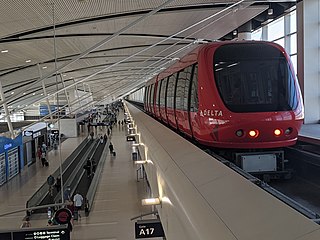
Transportation in metropolitan Detroit is provided by a system of transit services, airports, and an advanced network of freeways which interconnect the city of Detroit and the Detroit region. The Michigan Department of Transportation (MDOT) administers the region's network of major roads and freeways. The region offers mass transit with bus services provided jointly by the Detroit Department of Transportation (DDOT) and the Suburban Mobility Authority for Regional Transportation (SMART) through a cooperative service and fare agreement administered by the Regional Transit Authority (RTA). Cross border service between the downtown areas of Windsor and Detroit is provided by Transit Windsor via the Tunnel Bus. A monorail system, known as the People Mover, operates daily through a 2.94 mile (4.7 km) loop in the downtown area. A proposed SEMCOG Commuter Rail could link New Center, Dearborn, Detroit Metropolitan Airport, and Ann Arbor with access to DDOT and SMART buses. Amtrak's current passenger facility is north of downtown in the New Center area. Amtrak provides service to Detroit, operating its Wolverine service between Chicago, Illinois, and Pontiac. Greyhound Lines operates a station on Howard Street near Michigan Avenue. The city's dock and public terminal receives cruise ships on International Riverfront near the Renaissance Center which complements tourism in metropolitan Detroit.
Ottawa Electric Railway Company was a streetcar public transit system in the city of Ottawa, Canada, part of the electric railway streetcars that operated between 1891 and 1959. Ottawa once had tracks through downtown on Rideau Street, Sparks Street and others, and extended outside of the downtown core to provide services that helped form communities such as Westboro, Old Ottawa South and The Glebe. Prior to this, starting in 1866, public transportation was provided by Ottawa City Passenger Railway Company, a horse-drawn tram service. The O.E.R. was taken over by the Ottawa Transportation Commission in 1948, which was itself succeeded by OC Transpo in 1973.
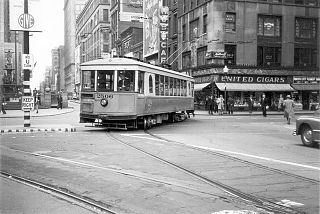
Streetcars operated by the Cincinnati Street Railway were the main form of public transportation in Cincinnati, Ohio, at the end of the 19th century and the start of the 20th century. The first electric streetcars began operation in 1889, and at its maximum, the streetcar system had 222 miles (357 km) of track and carried more than 100 million passengers per year. A very unusual feature of the system was that cars on some of its routes traveled via inclined railways to serve areas on hills near downtown. With the advent of inexpensive automobiles and improved roads, transit ridership declined in the 20th century and the streetcar system closed in 1951.


















